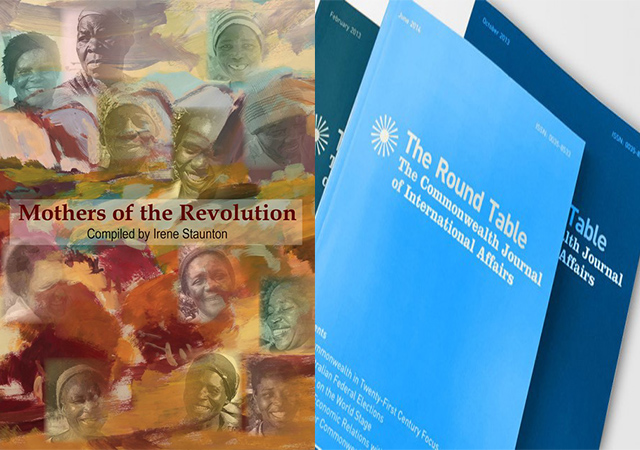
[This is an extract from a review in The Round Table: The Commonwealth Journal of International Affairs.]
‘Mothers of the Revolution’ is a marvellous work of social history. Irene Staunton, whose Weaver Press in Harare has been a bold and ambitious publisher in Zimbabwe’s time of troubles, gathered the stories of 30 rural women caught up in the civil war of the 1970s. There is a historic quality to this collection, first published in 1990, and it would be fascinating to reinterview those who are still alive over 30 years later.
This is a real insight into what the war in the countryside was like, told in the words of these brave but often uneducated women. Only one or two were politically active before the war, or even married to activists, such as Maudy Muzenda, whose husband Simon was a deputy vice-president of Zimbabwe in 1990 and had been involved in nationalist politics since the 1950s. Most were dragged into it, as husbands or sons slipped over the border to join ZANLA (the army of the Zimbabwe African Union of Robert Mugabe) or ZIPRA (the army of Joshua Nkomo’s Zimbabwe African People’s Union).
Life in the countryside was always hard for these women, caring for up to 14 children of whom some would die, doing the ploughing and hoeing to grow food, sometimes as a second wife, or left by husbands who went off for jobs in the cities or South Africa. Sons would disappear secretly to join these bush armies.
Many of the women do not distinguish between the ZANLAs and the ZIPRAs, who would arrive in a village, demanding food, and that the girls and women should wash and mend their clothes. The mujibas, the young boys, would become spies and messengers for these militias. The chimbwindos, the village girls, were given domestic duties, or required for sex and sometimes raped, so that they brought up as fatherless, the children of men who disappeared, or used false names.
But whether initially coerced, or as volunteers, these women came to support the guerrillas, killing chickens for them when they passed through a village, smuggling food past Rhodesian troops to ‘bases’ nearby, in the mountains or the bush. In some cases, their villages were relocated to protected ‘Keeps’, in a strategy, which Ian Smith borrowed from the Malayan Emergency and Vietnam. Although the guerrillas could behave badly, beating people up and forcing them to attend midnight pungwes or political education sessions, Smith’s troops, who tended to dash in and then disappear, were seen as more deadly. The Rhodesians quickly lost the battle for hearts and minds.
Often the most poignant parts of an interview relate to the end of the war, or when a woman went looking in one of the assembly areas where the guerrillas were required to disarm, during the 1980 elections which led to independence. Often a husband or son had never returned alive. Sometimes he looked so different, perhaps very thin, or so grown-up.
This is such a good book that one would like to know how the women feel now, after all the disappointments since 1990. Ndebele women lived through the Gukhurahundi, the violent war on ‘ZAPU dissidents’ which led up to the unity agreement and virtual one party state of 1987. All Zimbabweans would have witnessed the land invasions, hyper-inflation and collapse of services in the 21st century. What do they think now?
Mugabeism after Mugabe?, with its subtitle, Rethinking legacies and the new dispensation in Zimbabwe’s ‘Second Republic does not have much about public attitudes, although it provides a lot of material about the brief term so far of President Emmerson Mnangagwa. With the exception of one chapter, by James Hlongwana of the Great Zimbabwe University, the authors of eleven others in this collection are united in seeing the Mnangagwa’s ‘Second Republic’ as a continuity regime. Its ethnic bias within the Shona hegemony has changed, with appointees from Mugabe’s Zezuru clan replaced by people from Mnangagwa’s Karanga, but otherwise little alters. It is the same tight grip of a kleptocratic security nexus, dressed up with sub-marxist, nationalist rhetoric, while people go hungry, emigrate, and the economy tanks.
The claims to substantial change after Mugabe was deposed were rapidly exposed. Election results in August 2018 gave Mnangagwa a suspicious majority of 50.8%, enough to save him from a run-off, although in Mashonaland Central the election commission claimed that 400,000 had voted when only 105,000 had voted, 2 h before the polls closed. A demonstration in Harare by supporters of the opposition led the presidential guard to kill six people, wounding others with live rounds, and marauding troops beat up people in nearby Chitungwiza.
It is probably too early to say anything definitive about the Mnangagwa government, except that it demonstrates that Mugabe’s was not the dictatorship of an individual but a solid if reprehensible system.
Richard Bourne is an emeritus member of the Round Table editorial board.
Mothers of the revolution, compiled by Irene Staunton, Harare, Weaver Press, 2020.
Mugabeism after Mugabe? Rethinking legacies and the new dispensation in Zimbabwe’s ‘Second Republic’, edited by Fidelis Peter Thomas Duri, Ngonidzashe Marongwe & Munyaradzi Mawere, Masvingo, Africa Talent Publishers, 2020.



